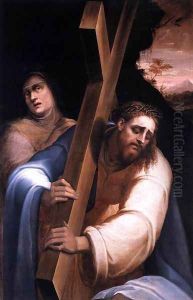Giovanni de' Vecchi Paintings
Giovanni de' Vecchi was an Italian painter of the late Renaissance period, born in 1536 in Borgo Sansepolcro, a town in Tuscany, Italy. His contributions to the art world are often celebrated for their vibrant colors, intricate details, and the incorporation of Mannerist elements, a style that emerged in the later years of the High Renaissance and is characterized by its artificiality and stylistic sophistication. De' Vecchi is known for his versatility in different mediums, including fresco and oil painting, and his ability to work on both secular and religious subjects.
De' Vecchi's early life and training are not extensively documented, but it is known that he was initially influenced by the works of Raphael and later by the Mannerist painters. His style evolved over time, reflecting the dynamic changes in art that characterized the late 16th century. He became particularly adept at creating complex compositions that conveyed movement and emotional intensity, traits that made his work stand out among his contemporaries.
Throughout his career, Giovanni de' Vecchi worked on numerous significant projects, including decorations for the Vatican and several Roman churches. One of his most famous works is the fresco cycle in the Oratory of San Giovanni Decollato in Rome, which showcases his skill in creating vivid narrative scenes. He was also involved in the decoration of the dome of the Basilica di Santa Maria Maggiore in Rome, a project that highlighted his mastery of large-scale compositions and his ability to work within the architectural constraints of the space.
De' Vecchi's influence extended beyond his individual works. He was part of a network of artists and intellectuals in Rome, contributing to the vibrant cultural landscape of the city during the late Renaissance. His legacy is seen in the way he combined the clarity and harmony of the High Renaissance with the emotional intensity and complexity of Mannerism, bridging the gap between these two artistic periods.
Giovanni de' Vecchi passed away in 1614. His body of work continues to be studied and admired for its artistic innovation and its reflection of the cultural and intellectual currents of his time. Through his contributions to the art of fresco painting and his exploration of both religious and secular themes, de' Vecchi has secured his place in the history of Italian Renaissance art.
